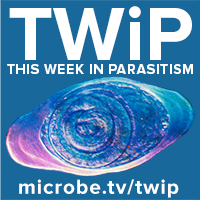The TWiP quadfecta solves the case of the Traveler With Watery Diarrhea, and reveals that a heat-shock response regulated by a transcription factor protects human malaria parasites from the high temperatures of fever.
Hosts: Vincent Racaniello, Dickson Despommier, Daniel Griffin, and Christina Naula
Click arrow to play
Download TWiP #198 (39 MB .mp3, 64 minutes)
Subscribe (free): iTunes, Google Podcasts, RSS, email
Links for this episode
- PWB on Facebook, Instagram, Twitter
- Malaria parasite resists fever due to heat shock response (Nat Micro)
- Malaria beats the heat (Nat Micro)
- Letters read on TWiP 198
Become a patron of TWiP
Case Study for TWiP 198
31 yo woman, previously healthy, traveled to Tanzania, went on 11 day long safari. One week later, at home, developed fever and severe headache, went into hospital. Thick blood smears negative, physical exam normal, small purple lesion near buttocks. Started on treatment for African tick bite fever. Did not get better, lesion grew in size. Biopsy of lesion, nothing remarkable on microscopy. Improved, sent home, 10 days another bout of fever that went down in 2 days. Lesion healed. PCR for plasmodium, Borrelia negative, but seroconverted for Rickettsia. Went home, a week later another 3 day bout of fever.
Send your case diagnosis, questions and comments to [email protected]
Music by Ronald Jenkees


Please cover Mosquirix and the deployment of GMO modified male mosquitos in Florida in a future episode.
Dear TWIP Team,
I learned yesterday that you will do an episode of TWIP on the malaria vaccine “Mosquirix”, which was approved yesterday by the WHO. The vaccine, which has been referred to in scientific publications as “RTS,S”, was invented by SmithKline Beecham, but the Walter Reed Army Institute of Research (WRAIR) has been collaborating with SmithKline Beecham and its successor, GlaxoSmithKline (GSK), in testing this vaccine since 1984.
A new circumsporozoite protein-hepatitis B surface antigen (CSP–HBsAg) fusion protein was developed at SmithKline Beecham, which incorporated the CSP C-terminal flanking region known to contain B- and T-cell epitopes into a chimeric gene expressed in Saccharomyces cerevisiae. This construct was named “RTS” to indicate the presence of the CSP repeat region (R),T-cell epitopes (T), and the hepatitis B surface antigen (S). Exigencies of purification led to the co-expression and purification of additional antigen in a ratio of RTS to S of 1:4, hence the name “RTS,S.” The antigen has been given along with one of the adjuvants made by GSK, which include monophophoryl lipid A and Quillaja saponaria Molina extract.
Please don’t ignore us when you discuss the vaccine. Here are a few of the papers we wrote about it:
Moon, J.E. et al.: A Phase IIa Controlled Human Malaria Infection and Immunogenicity Study of RTS,S/AS01E and RTS,S/AS01B Delayed Fractional Dose Regimens in Malaria-Naive Adults. J Infect Dis. 2020 Nov 15; 222(10): 1681–1691.
Published online 2020 Jul 20. doi: 10.1093/infdis/jiaa421
Stoute, J.A. et al.: A Preliminary Evaluation of a Recombinant Circumsporozoite Protein Vaccine against Plasmodium falciparum Malaria. N Engl J Med 1997; 336:86-91. DOI: 10.1056/NEJM199701093360202
Gordon, D.M. et al.: Safety, immunogenicity, and efficacy of a recombinantly produced Plasmodium falciparum circumsporozoite protein-hepatitis B surface antigen subunit vaccine. J Infect Dis. 1995 Jun;171(6):1576-85.
doi: 10.1093/infdis/171.6.1576.
Ballou, W.R. et al.: Safety and efficacy of a recombinant DNA Plasmodium falciparum sporozoite vaccine. Lancet 1987 DOI: 10.1016/s0140-6736(87)90540-x
Jack Komisar
(Retired from WRAIR in 2019).